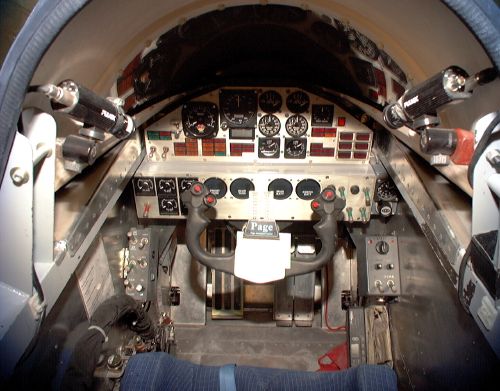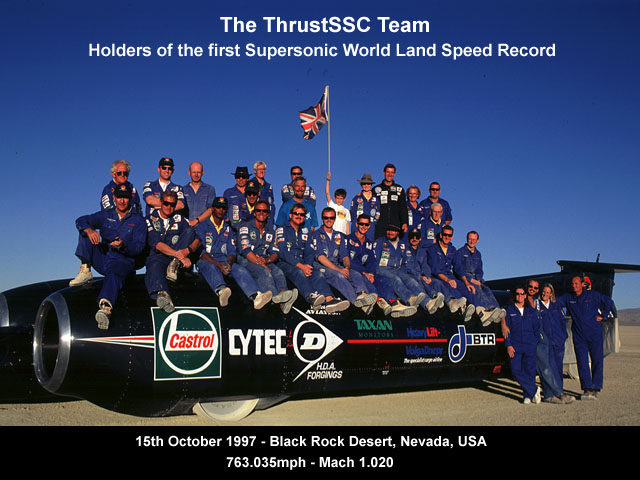 Gaining access to a Cray Research 92 computer with Flite aviation design
software enabled them to refine the concept, using computational fluid
dynamics. After
a great deal of work, they were able to predict the car's performance
under a variety of conditions.
Gaining access to a Cray Research 92 computer with Flite aviation design
software enabled them to refine the concept, using computational fluid
dynamics. After
a great deal of work, they were able to predict the car's performance
under a variety of conditions.
The concept looked promising, but the team wanted to be absolutely
certain that they were taking the correct approach. An accurate, 1/25th-scale
model
was built, and run on a military rocket sled track at Pendine Sands in
South Wales, where it was mounted in front of a rocket and run at
supersonic
speeds. After each pass it was lowered, until at the end it skimmed
across the surface of the track. Data collected from these tests enabled
the team to become
the first to fully understand what really happens to the air underneath a
car when it goes faster than the speed of sound.
Another breakthrough followed. The data from the computer projections
and the supersonic scale model testing were then compared. To the
amazement of everyone
involved, the conclusions from both testing methods correlated almost
exactly.
 Noble wisely decided that since this was to be an exceptional race car,
its driver must have some exceptional skills. And the more the project
progressed, the
more it became apparent that he needed to focus on its other aspects:
Noble wisely decided that since this was to be an exceptional race car,
its driver must have some exceptional skills. And the more the project
progressed, the
more it became apparent that he needed to focus on its other aspects:
"My situation is that I have made a very, very painful decision not to
drive. We're in a situation where, to get the car operational by next
year, we've got to
go for one hell of a build operation. Basically, to fund that and to
manage that is going to be a tremendous undertaking. The reality is that
we've got to find
somebody who has got to live with the team, who has got to actually
train up with the team, and who will then become the car's driver."
A competitive selection process took place to see who would drive the
fastest car ever built. But rather than advertise for people to apply,
he simply allowed
the message to spread, thereby providing the applicants with their first
test — their own initiative.
Thirty people applied. All of them were either drag racers or pilots. At
the Center of Human Sciences in Farnborough, Professor Roger Green
provided help with
the project:
"What we had to do was decide how to whittle this down further. The most
obvious thing to do was to give them all a sanity test and take the
ones who failed.
But one Richard Noble is obviously quite enough already."
The ability to be part of a team was given equal importance as being
able to control the race car. Based on their experience, the thirty were
first narrowed
down to sixteen, who were given numerous intelligence and personality
tests. The goal was to find the most analytical individuals, who would
be likely to
contribute the most in solving problems, both in controlling ThrustSSC,
and in its design.
Eight remained, all of whom were pilots. The next objective was to find
out who could handle extreme stress and discomfort for extended periods,
and yet still
be part of a team that was working toward a common goal.
For most of two days and both nights, the eight were kept at the Center
of Human Sciences. The Thrust team was to spend a great deal of time
working for long
hours on a hot desert. As a surprise, they were kept awake all night in a
heat chamber, where they were filmed at all times and given difficult
computer-based
tests at periodic intervals, to see how fatigue and stress affected
their performance.
British rally champion Russell Brooks gave the five potential drivers
that remained the opportunity to drive a Formula Two rally car in time
trials as quickly
as their abilities allowed. Feedback from Brooks narrowed the five down
to four, who then interacted with the rest of the team, facing design
challenges.
Finally, without the four realizing it, the members of the team filled
out questionnaires asking their opinions.
 Of all of the contenders, one man came out on top: a British Royal Air Force jet fighter pilot named Andy Green.
Of all of the contenders, one man came out on top: a British Royal Air Force jet fighter pilot named Andy Green.
But once the car had been designed, and the driver and race track
selected, the logistics in the project that remained were staggering.
There was the cost of
building the car, testing it, bringing it from England to the desert in
Nevada and back, and looking after a substantial support crew. Richard
knew that in
order for this to happen, he would need a lot of help from a lot of
talented and dedicated people working together. The more the concept of
Noble, Ayers,
Bowsher, Green and the rest of the team was refined, the more it seemed
that the most significant obstacle to overcome was in raising the
enormous amount of
money it would take.
Robin Richardson suggested forming the Mach 1 Club, which provided a way
for land speed record racing enthusiasts to become involved in
everything from
publicity to fundraising through the sale of memberships and souvenirs.
Early on, Castrol and Dunlop had become sponsors of the ThrustSSC
project. This was a big help, but it would take far more. In the hope of
securing the
sponsorship that would make it possible to race the car, Noble took his
vision to a number of large corporations, explaining what he was going
to do, and what
it would mean to the United Kingdom and to the automotive industry.
People listened, but none stepped up with a commitment to provide all
that was needed. He
continued knocking on corporate doors. "Quite impressive, Mr. Noble.
Call us when you've done it."
This was in the mid-1990s, a time when the Internet was new to most of the world. And there was the answer.
In April of 1995, team member Robin Richardson obtained help from his
employer, Digital, in launching a Web site for the ThrustSSC project. In
November of
1995, Nick Chapman and Jeremy Davey took on the responsibility of
managing the site. In essence, the message was that ThrustSSC was being
built, and it was
going to be the fastest car in history. It was also going to be the
first car to officially break the sound barrier. But considerable help
was needed to make
it all happen. The necessary technology, equipment, and projected costs
were outlined.
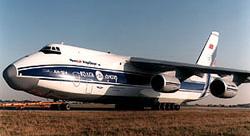 Arrangements were made to borrow the largest airplane in the world, the
Russian Antonov 124 cargo plane. The Antonov would make it possible to
transport the
completed race car, its spare jet engines, spare parts, tools, pit
control station, computers and data acquisition equipment, all of the
required support cars,
trucks, trailers, and ATVs, ultralight aircraft for flying overhead to
check the track and take photographs, a number of big tents to protect
everything, and a
whole lot of fuel.
Arrangements were made to borrow the largest airplane in the world, the
Russian Antonov 124 cargo plane. The Antonov would make it possible to
transport the
completed race car, its spare jet engines, spare parts, tools, pit
control station, computers and data acquisition equipment, all of the
required support cars,
trucks, trailers, and ATVs, ultralight aircraft for flying overhead to
check the track and take photographs, a number of big tents to protect
everything, and a
whole lot of fuel.
On the Web site, mention was made that in order to do all of this, it
would take a total of 250,000 gallons of fuel. If no single source was
going to provide
it, would some of you care to help by buying 25 gallons?
British television and radio picked up the story. Traffic to the site
began to grow. All through the United Kingdom, a sense of duty and pride
led to everyone
from executives to young children sending in payments for 25 gallons, a
hundred gallons — whatever they were able to share.
Not only was history made by building and racing the ThrustSSC
successfully, but their Web site demonstrated the potential of the
Internet as a means of
sharing a story with the world, and for helping to create the interest
and support in a project that ultimately made it possible for the team
to meet a goal
that relatively few believed would ever be possible.
 Special thanks go to Jeremy Davey, the Webmaster of the ThrustSSC Web
site, who took most of the pictures that appear in this article. Until
the team reached
their objective, their site was revised regularly. Jeremy Davey did a
superb job of sharing the excitement and suspense of their adventure
with the rest of the
world.
Special thanks go to Jeremy Davey, the Webmaster of the ThrustSSC Web
site, who took most of the pictures that appear in this article. Until
the team reached
their objective, their site was revised regularly. Jeremy Davey did a
superb job of sharing the excitement and suspense of their adventure
with the rest of the
world.
The ThrustSSC Web site can be found at
http://www.thrustssc.com/
A souvenir CD-ROM made up of the entire ThrustSSC site is available. It
contains the entire story, including lots of engineering information, a
number of audio
and video clips, and thousands of photographs. Proceeds from the sale of
the CD-ROM and from other souvenirs go towards paying back loans that
were made to the
team for this extremely expensive endeavor.
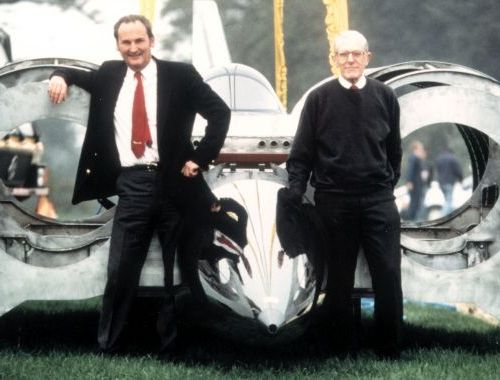 Shown on the right are world land speed record holder Richard Noble
(left) and aerodynamicist Ron Ayers (right), standing beside ThrustSSC
as its construction
was underway.
Shown on the right are world land speed record holder Richard Noble
(left) and aerodynamicist Ron Ayers (right), standing beside ThrustSSC
as its construction
was underway.
In an article written by Andrew Graves, published in the January 1998
issue of Prototyping Technology, Ayers explained his role in the
project.
"The rocket sled tests confirmed our computer predictions. At that
stage, my job as an aerodynamicist was substantially done. The shape was
defined."
"I became more involved again when the car was running. This was because
I then had to specify what its performance capabilities were and define
the run
profiles for each run and effectively define each run as a scientific
experiment. A run profile includes the rate of acceleration and at what
level the car
reaches certain speeds."
"The third member of our design team is a chap called Jeremy Bliss, who
used to do active suspension on Formula 1 in the days when it was
allowed."
"Experiments included exercising the active suspension by pushing it up
and down, partly to test it, but also to check the aerodynamic
characteristics of the
car during a range of circumstances."
"There were over 120 sensors on the car measuring everything you can
think of, from the wheel loads to the bearing temperatures, the brake
temperatures, the
aerodynamic pressures on thirty different points, hydraulic pressures,
engine characteristics and fuel forces. So we treated it like a first
prototype
airplane, going a little faster each time and checking the data."
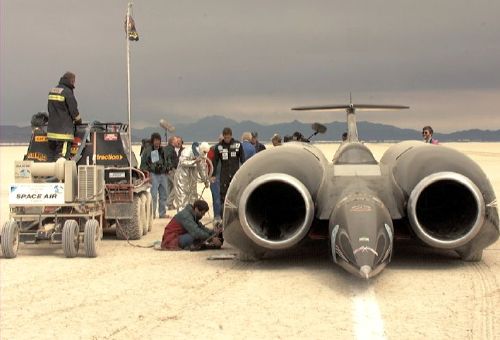 "We could download the data between runs and check the safety-critical
items like the wheel loads on the desert, the bearing temperatures, et
cetera. We did
this between runs, even when we were breaking records and we had to do
the turnaround within the hour. While we were refueling the car, which
took about twenty
minutes, we could download data that myself, Glynne Bowsher, Jeremy
Bliss and probably Andy Green, the driver, would then check. We knew in
advance what we
wanted to check. We could call up that data and check that the lines
were where we expected them to be on the graphs, and that there was
nothing near to the
limits. If this was so, then we would authorize the next run."
"We could download the data between runs and check the safety-critical
items like the wheel loads on the desert, the bearing temperatures, et
cetera. We did
this between runs, even when we were breaking records and we had to do
the turnaround within the hour. While we were refueling the car, which
took about twenty
minutes, we could download data that myself, Glynne Bowsher, Jeremy
Bliss and probably Andy Green, the driver, would then check. We knew in
advance what we
wanted to check. We could call up that data and check that the lines
were where we expected them to be on the graphs, and that there was
nothing near to the
limits. If this was so, then we would authorize the next run."
In an interview published on the ThrustSSC Web site, former missile designer Ayers provided these cheerful thoughts:
"If the front of the car lifts by as little as one degree, or even half a
degree, all the weight will come off the front wheels. The car will
then nose up and
flip over backwards. The forces acting upon it at maximum speed will be
in excess of forty times the force of gravity."
"If the nose comes up, you're going flying. But equally, if it goes
down, then you're going mining. The car's aerodynamic behavior has got
to be
neutral."
 Jeremy Bliss designed an active rear suspension system to allow the rake
of the car to be adjusted during its runs, very quickly. It worked
quite well.
Jeremy Bliss designed an active rear suspension system to allow the rake
of the car to be adjusted during its runs, very quickly. It worked
quite well.
ThrustSSC is fifty-four feet long, and twelve feet wide. It is powered
by a pair of Rolls-Royce Spey 202 jet engines from a Phantom fighter
producing 50,000
pounds of thrust and 110,000 horsepower. Easily as awesome as any car
ever built, ThrustSSC is an incredible achievement and an overwhelming
sight.
 Some think the car looks like a giant hot dog. An article Ayers wrote about the shape of the car contains a story worth sharing:
Some think the car looks like a giant hot dog. An article Ayers wrote about the shape of the car contains a story worth sharing:
"The shape of the car has certainly aroused much comment. Everyone
agrees it is impressive. Many people have said it is beautiful. One
young lady disagreed.
She told me in accusing tones that the shape I had designed was the
ultimate male sex symbol. Lamely, I shrank from asking her what
geometric modifications
would be required to turn it into a female sex symbol. I contented
myself by telling her that the shape had been designed by mathematics,
and that I would
check the equations to see which one contained the gender information."
After its construction, the car was taken to a 7,000-foot airfield in
Farnborough, where low-speed tests verified that all systems performed
as
intended.
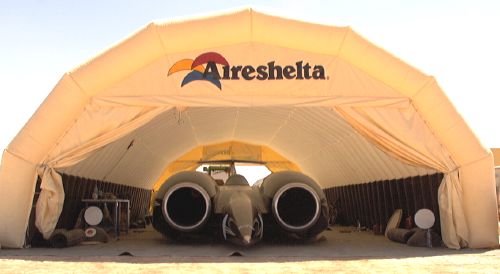 Then another longtime racing fan became involved. King Hussein of Jordan
provided access to a large area of the Jafr desert, with the full
cooperation of the
Jordanian Army. On two visits a number of test runs were made. The team
spent thousands of hours clearing a course for the car to run on,
battling dust storms
and torrential rain.
Then another longtime racing fan became involved. King Hussein of Jordan
provided access to a large area of the Jafr desert, with the full
cooperation of the
Jordanian Army. On two visits a number of test runs were made. The team
spent thousands of hours clearing a course for the car to run on,
battling dust storms
and torrential rain.
Back in the UK, Aireshelta flew in a huge inflatable shelter to house
the race car. The desert surface ultimately proved to be too uneven for
the car to go
beyond 540 miles per hour, and a rear suspension bracket was damaged.
Nonetheless, ThrustSSC essentially performed very well, and was found to
be stable and
safe.
With just a few weeks remaining before the team's scheduled departure to
Black Rock, further refinements and minor repairs were carried out. At
this point, now
that people could see that the team had a very real chance of success,
more sponsors became involved, and new equipment was added. For the
first time since the
team had begun their adventure, there was no doubt that the trip to
Black Rock was going to proceed according to plan.
 After the final adjustments and improvements were made to the car,
ThrustSSC was pronounced ready for its mission. It was time to make
history.
After the final adjustments and improvements were made to the car,
ThrustSSC was pronounced ready for its mission. It was time to make
history.
Craig Breedlove and the Spirit of America race team were already at
Black Rock, preparing for their own assault on the land speed record,
and the sound
barrier.
Everything that was needed, totaling almost ninety tons, was loaded into
the Antonov cargo plane and flown to Gander, Newfoundland for a fuel
stop, and then on
to Reno, Nevada.
After the flight, the crew, the race car, and all of the team's equipment were transported to the Black Rock Desert.
Six miles of the desert were used to bring the car up to the timing
lights set a few hundred feet apart. Then comes the measured mile, where
the speed of the
car is recorded. Another six miles were used to bring the car to a stop.
To mark the race course, a mixture of gypsum and water was used to create perfectly straight lines twelve miles long.
 The desert has been used as a firing range, and is littered with
thousands of artillery shells. The entire course had to be inspected and
cleared of anything
that might cause damage to the race car's engines or wheels.
The desert has been used as a firing range, and is littered with
thousands of artillery shells. The entire course had to be inspected and
cleared of anything
that might cause damage to the race car's engines or wheels.
In early September of 1997, the stage was finally set for the ultimate
car race — to be the first to officially break the sound barrier in a
race
car.
Between setting up their equipment, preparing the race course,
mechanical challenges involved in taking care of the race car and
continuing to refine it, press
conferences, documenting everything, and waiting for the Spirit of
America to make runs, the team spent over two months on the desert.
Andy Green rather casually went about his mission of driving ThrustSSC.
Andy's skills as a British Royal Air Force pilot were put to good use.
On September 25th of 1997, the ThrustSSC team reached one of
their goals by setting a new World Land Speed Record, with a two-way
average speed of
714.144 miles per hour.

The new record was below the speed of sound, but it nonetheless clearly
proved the project worthwhile. The team had designed, built and raced
the fastest car
in history.
A few days later, an unofficial burst up to 750 miles per hour proved
that the car could go supersonic and remain controllable. The design
ideas of Ron Ayers,
Glynne Bowsher, Jeremy Bliss and rest of the team, along with Richard
Noble's perseverance, and Andy Green's talent and experience had once
again proven
themselves.
Then, on Monday, October 13th, Andy and the ThrustSSC team shocked the world with two runs, at 764.168 miles per hour (Mach 1.007) and 760.135 miles
per hour (Mach 1.003).
|













































 It has been said that the first car race probably took place the first
time two cars pulled up beside each other. And ever since then, there
has been
competition to see who could go the fastest.
It has been said that the first car race probably took place the first
time two cars pulled up beside each other. And ever since then, there
has been
competition to see who could go the fastest. On September 4th, 1997, Breedlove and the Spirit of America
crew began testing the car at Black Rock. Breedlove and his team
struggled with
everything from a damaged engine (and a spare engine back in California
that they hadn't even brought with them) to getting their truck and
trailer stuck in
the mud (and then being pulled out by the members of the ThrustSSC
team).
On September 4th, 1997, Breedlove and the Spirit of America
crew began testing the car at Black Rock. Breedlove and his team
struggled with
everything from a damaged engine (and a spare engine back in California
that they hadn't even brought with them) to getting their truck and
trailer stuck in
the mud (and then being pulled out by the members of the ThrustSSC
team). Richard Noble had a vision. He wanted to beat the world land speed
record, and he believed he could do it. The record to beat was his own,
set on October
4th, 1983 in Thrust 2, a jet car that was designed by John
Ackroyd, with brakes and wheels that were designed with the help of
Glynne
Bowsher.
Richard Noble had a vision. He wanted to beat the world land speed
record, and he believed he could do it. The record to beat was his own,
set on October
4th, 1983 in Thrust 2, a jet car that was designed by John
Ackroyd, with brakes and wheels that were designed with the help of
Glynne
Bowsher. Glynne Bowsher, who had helped Noble with the design of the Thrust 2,
was happy to be able to contribute to the new project as the mechanical
and structural
designer.
Glynne Bowsher, who had helped Noble with the design of the Thrust 2,
was happy to be able to contribute to the new project as the mechanical
and structural
designer. Arrows are made with weight at the front, so to provide stability, a
forward center of gravity was called for. Concern for the safety of the
driver lead to the
decision to use two jet engines, with one on either side of the driver.
At speed, this would make it easier for the driver to have a feel for
what the car was
doing. As a bonus, the two engines would also provide enough thrust to
overcome tremendous aerodynamic drag and rolling resistance.
Arrows are made with weight at the front, so to provide stability, a
forward center of gravity was called for. Concern for the safety of the
driver lead to the
decision to use two jet engines, with one on either side of the driver.
At speed, this would make it easier for the driver to have a feel for
what the car was
doing. As a bonus, the two engines would also provide enough thrust to
overcome tremendous aerodynamic drag and rolling resistance.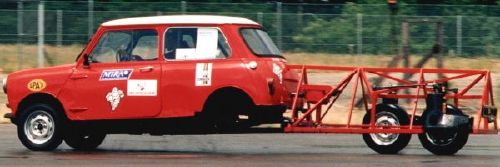 Amongst considerable skepticism, a scaled-down version of the car's
proposed wheel layout was built, using an old Austin Mini that belonged
to Bowsher's
brother-in-law.
Amongst considerable skepticism, a scaled-down version of the car's
proposed wheel layout was built, using an old Austin Mini that belonged
to Bowsher's
brother-in-law. Gaining access to a Cray Research 92 computer with Flite aviation design
software enabled them to refine the concept, using computational fluid
dynamics. After
a great deal of work, they were able to predict the car's performance
under a variety of conditions.
Gaining access to a Cray Research 92 computer with Flite aviation design
software enabled them to refine the concept, using computational fluid
dynamics. After
a great deal of work, they were able to predict the car's performance
under a variety of conditions. Noble wisely decided that since this was to be an exceptional race car,
its driver must have some exceptional skills. And the more the project
progressed, the
more it became apparent that he needed to focus on its other aspects:
Noble wisely decided that since this was to be an exceptional race car,
its driver must have some exceptional skills. And the more the project
progressed, the
more it became apparent that he needed to focus on its other aspects: Of all of the contenders, one man came out on top: a British Royal Air Force jet fighter pilot named Andy Green.
Of all of the contenders, one man came out on top: a British Royal Air Force jet fighter pilot named Andy Green. Arrangements were made to borrow the largest airplane in the world, the
Russian Antonov 124 cargo plane. The Antonov would make it possible to
transport the
completed race car, its spare jet engines, spare parts, tools, pit
control station, computers and data acquisition equipment, all of the
required support cars,
trucks, trailers, and ATVs, ultralight aircraft for flying overhead to
check the track and take photographs, a number of big tents to protect
everything, and a
whole lot of fuel.
Arrangements were made to borrow the largest airplane in the world, the
Russian Antonov 124 cargo plane. The Antonov would make it possible to
transport the
completed race car, its spare jet engines, spare parts, tools, pit
control station, computers and data acquisition equipment, all of the
required support cars,
trucks, trailers, and ATVs, ultralight aircraft for flying overhead to
check the track and take photographs, a number of big tents to protect
everything, and a
whole lot of fuel. Special thanks go to Jeremy Davey, the Webmaster of the ThrustSSC Web
site, who took most of the pictures that appear in this article. Until
the team reached
their objective, their site was revised regularly. Jeremy Davey did a
superb job of sharing the excitement and suspense of their adventure
with the rest of the
world.
Special thanks go to Jeremy Davey, the Webmaster of the ThrustSSC Web
site, who took most of the pictures that appear in this article. Until
the team reached
their objective, their site was revised regularly. Jeremy Davey did a
superb job of sharing the excitement and suspense of their adventure
with the rest of the
world. Shown on the right are world land speed record holder Richard Noble
(left) and aerodynamicist Ron Ayers (right), standing beside ThrustSSC
as its construction
was underway.
Shown on the right are world land speed record holder Richard Noble
(left) and aerodynamicist Ron Ayers (right), standing beside ThrustSSC
as its construction
was underway. "We could download the data between runs and check the safety-critical
items like the wheel loads on the desert, the bearing temperatures, et
cetera. We did
this between runs, even when we were breaking records and we had to do
the turnaround within the hour. While we were refueling the car, which
took about twenty
minutes, we could download data that myself, Glynne Bowsher, Jeremy
Bliss and probably Andy Green, the driver, would then check. We knew in
advance what we
wanted to check. We could call up that data and check that the lines
were where we expected them to be on the graphs, and that there was
nothing near to the
limits. If this was so, then we would authorize the next run."
"We could download the data between runs and check the safety-critical
items like the wheel loads on the desert, the bearing temperatures, et
cetera. We did
this between runs, even when we were breaking records and we had to do
the turnaround within the hour. While we were refueling the car, which
took about twenty
minutes, we could download data that myself, Glynne Bowsher, Jeremy
Bliss and probably Andy Green, the driver, would then check. We knew in
advance what we
wanted to check. We could call up that data and check that the lines
were where we expected them to be on the graphs, and that there was
nothing near to the
limits. If this was so, then we would authorize the next run." Jeremy Bliss designed an active rear suspension system to allow the rake
of the car to be adjusted during its runs, very quickly. It worked
quite well.
Jeremy Bliss designed an active rear suspension system to allow the rake
of the car to be adjusted during its runs, very quickly. It worked
quite well. Some think the car looks like a giant hot dog. An article Ayers wrote about the shape of the car contains a story worth sharing:
Some think the car looks like a giant hot dog. An article Ayers wrote about the shape of the car contains a story worth sharing: Then another longtime racing fan became involved. King Hussein of Jordan
provided access to a large area of the Jafr desert, with the full
cooperation of the
Jordanian Army. On two visits a number of test runs were made. The team
spent thousands of hours clearing a course for the car to run on,
battling dust storms
and torrential rain.
Then another longtime racing fan became involved. King Hussein of Jordan
provided access to a large area of the Jafr desert, with the full
cooperation of the
Jordanian Army. On two visits a number of test runs were made. The team
spent thousands of hours clearing a course for the car to run on,
battling dust storms
and torrential rain. After the final adjustments and improvements were made to the car,
ThrustSSC was pronounced ready for its mission. It was time to make
history.
After the final adjustments and improvements were made to the car,
ThrustSSC was pronounced ready for its mission. It was time to make
history. The desert has been used as a firing range, and is littered with
thousands of artillery shells. The entire course had to be inspected and
cleared of anything
that might cause damage to the race car's engines or wheels.
The desert has been used as a firing range, and is littered with
thousands of artillery shells. The entire course had to be inspected and
cleared of anything
that might cause damage to the race car's engines or wheels.
 The unaltered photograph on the right is one of a series of pictures taken by
The unaltered photograph on the right is one of a series of pictures taken by
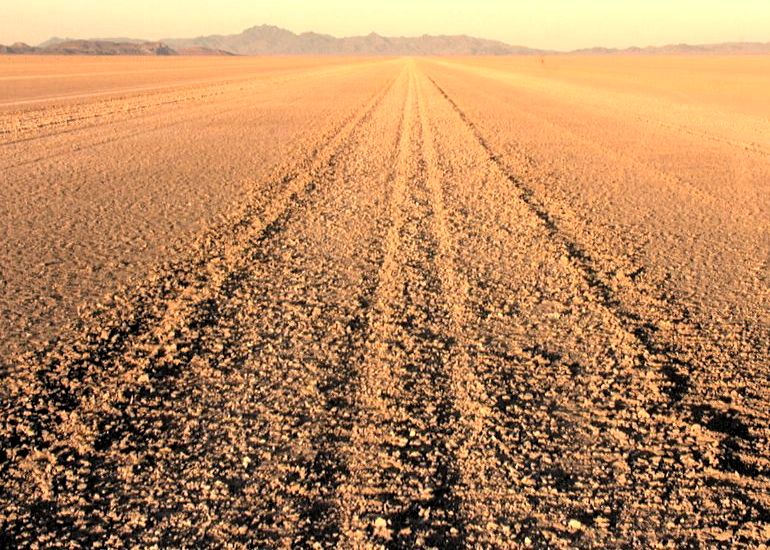
 On Wednesday, October 15th, 1997, the ThrustSSC team made two more runs. The first, the car's 65th run, was timed at 759.333 miles per
hour, which is Mach 1.015. The all-important backup run was successfully made within the hour, at 766.609 miles per hour.
On Wednesday, October 15th, 1997, the ThrustSSC team made two more runs. The first, the car's 65th run, was timed at 759.333 miles per
hour, which is Mach 1.015. The all-important backup run was successfully made within the hour, at 766.609 miles per hour.